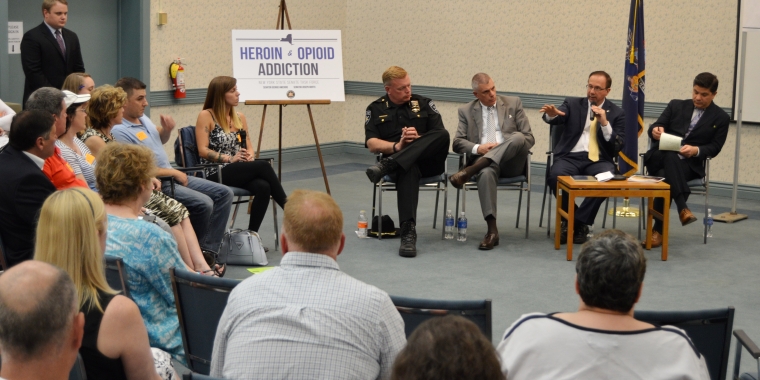
Griffo applauds legislative agreement to combat crisis of heroin and prescription opioid abuse in NY
June 14, 2016

ALBANY -- State Senator Joseph Griffo applauded the Legislature and the Governor on Tuesday following their agreement on new legislation to fight heroin and prescription opioid abuse across New York State.
"I recently hosted a community forum on this public health crisis, and listened to heartbreaking stories from people from Central New York who are struggling with addiction or grieving the deaths of loved ones from heroin overdose," said Senator Griffo, R-Rome. "I am pleased to see that action is being taken to save our communities from this devastating epidemic."
Senator Griffo continued, "We continue to lose too many of our citizens to this insidious addiction. The Senate intensified its efforts to fight this problem two years ago by forming the Senate Joint Task Force on Heroin and Opioid Addiction, and as a result we have already passed numerous laws and secured $189 million in the budget to improve our strategies in prevention, treatment, education and law enforcement. For the sake of our families and communities that have already lost too much to heroin and opioids, I am glad to see this legislation continue to build upon our efforts to get this crisis under control."
The package of three bills includes wide-ranging initiatives, such as provisions that limit the over-prescription of opioids and removes barriers to access for inpatient treatment and medication. This legislation would also eliminate burdensome insurance barriers to treatment and require mandatory prescriber education on pain management in order to stem the tide of addiction.
ELIMINATES BURDENSOME INSURANCE BARRIERS TO INCREASE ACCESS TO NEEDED ADDICTION TREATMENT:
Ends Prior Insurance Authorization to Allow for Immediate Access to Inpatient Treatment as Long as Such Treatment is Needed: People suffering from addiction who seek treatment need immediate access to services, but prior authorization requirements by insurance companies are often a roadblock to admission to inpatient programs. This legislation requires insurers to cover necessary inpatient services for the treatment of substance use disorders for as long as an individual needs them. In addition, the legislation establishes that utilization review by insurers can begin only after the first 14 days of treatment, ensuring that every patient receives at least two weeks of uninterrupted, covered care before the insurance company becomes involved.
Ends Prior Insurance Authorization to Allow for Greater Access to Drug Treatment Medications: People seeking medication to manage withdrawal symptoms or maintain recovery must often request prior approval from their insurance company, which slows or stops the individual from getting needed medication. This legislation prohibits insurers from requiring prior approval for emergency supplies of these medications. Similar provisions will also apply to managed care providers treating individuals on Medicaid who seek access to buprenorphine and injectable naltrexone.
Requires All Insurance Companies Use Objective State-Approved Criteria to Determine the Level of Care for Individuals Suffering from Substance Abuse: Insurance companies often use inconsistent criteria to determine the covered level of care for persons suffering from substance use disorder, which often creates barriers preventing these individuals from receiving care. This legislation will require all insurers operating in New York State to use objective, state-approved criteria when making coverage determinations for all substance use disorder treatment in order to make sure individuals get the treatment they need.
Mandate Insurance Coverage for Opioid Overdose-Reversal Medication: Naloxone is a medication that revives an individual from a heroin or opioid overdose and has saved thousands of New Yorkers’ lives. To expand access to this life-saving medication, the new legislation requires insurance companies to cover the costs of naloxone when prescribed to a person who is addicted to opioids and to his/her family member/s on the same insurance plan.
TREATMENT ENHANCEMENTS:
Increase Evaluation for Individuals Incapacitated by Drugs from 48 to 72-Hours: Sometimes, individuals suffering from addiction are at risk for overdose and thus pose a threat to themselves. The legislation allows families to seek 72-hours of emergency treatment, an increase from the current 48-hours, for their loved one to stabilize and connect them to longer-term treatment options while also balancing individual rights of the incapacitated individuals.
Require Hospitals to Provide Follow-Up Treatment Service Options to Individuals Upon Hospital Discharge: Hospitals play an important role in caring for individuals suffering from addiction who are often admitted to hospital emergency rooms after an overdose. This legislation requires hospital medical staff to provide discharge-planning services to connect patients who have or are at-risk for substance use disorder with nearby treatment options to provide continuous medical care.
Allow More Trained Professionals to Administer Life-Saving Overdose-Reversal Medication: Overdose-reversal medication such as naloxone saves lives. However, the law does not currently allow certain licensed professionals to administer this medication to individuals overdosing from heroin and opioids. To ensure that more people are able to help reverse overdoses, the new legislation authorizes trained professionals to administer naloxone in emergency situations without risk to their professional license.
Expand Wraparound Services to Support Long-Term Recovery: Individuals leaving treatment are at great risk for relapse. To provide services during this critical period, the legislation extends the wraparound program launched in 2014 to provide services to individuals completing treatment including education and employment resources; legal services; social services; transportation assistance, childcare services; and peer support groups.
PREVENTION:
Reduce Prescription Limits for Opioids from 30-days to Seven Days: There is a well-established link between the rise in opioid prescriptions and the current heroin crisis. To reduce unnecessary access to opioids, the legislation lowers the limit for opioid prescriptions for acute pain from 30-days to no more than a 7-day supply, with exceptions for chronic pain and other conditions.
Require Ongoing Education on Addiction & Pain Management for All Physicians and Prescribers: Physicians and other opioid prescribers are important partners in preventing addiction linked to abuse of prescription opioids. To ensure that prescribers understand the risks presented by prescription opioids, the legislation mandates that these health care professionals complete three hours of education every three years on addiction, pain management, and palliative care.
Mandate Pharmacists Provide Easy to Understand Information on Risks Associated with Drug Addiction and Abuse: Consumers may not understand the addiction and abuse risks posed by prescription opioids. To improve consumer awareness about these risks the legislation requires pharmacists to provide educational materials to consumers about the risk of addiction, including information about local treatment services.
Require Data Collection on Overdoses and Prescriptions to Assist the State in Providing Additional Protections to Combat this Epidemic: Current and accurate data is critical to combat the heroin and opioid crisis yet gaps currently exist in statewide data on overdoses and usage of opioid reversal medication. To fill that gap the legislation requires the State Commissioner of Health to report county-level data on opioid overdoses and usage of overdose-reversal medication on a quarterly basis.
ADDITIONAL INITIATIVES TO COMBAT ADDICTION
The 2016-2017 budget invests nearly $200 million through the New York State Office of Alcoholism and Substance Abuse Services to combat the heroin and opioid epidemic -- an 82 percent increase in state spending since 2011. This investment includes $66 million for residential treatment beds, including counseling and support services for roughly 8,000 individuals; $38 million to fund medication-assisted treatment programs that serve approximately 12,000 clients in residential or outpatient settings; $25 million in funding for state-operated Addiction Treatment Centers; $24 million for outpatient services that provide group and individual counseling; and $8 million for crisis/detox programs to manage and treat withdrawal from heroin and opioids.
Today’s agreement also allocates funding to add 270 treatment beds and 2,335 opioid treatment program slots across the state to help New Yorkers suffering from substance use disorder and to expand vital treatment and recovery resources.
The agreement funds additional family support navigators across New York to assist substance users and their families locate and access treatment options and cope with addiction. The agreement will also expand the on-call peer program which partners individuals in recovery with people in hospitals suffering from substance use disorder to help connect these individuals to treatment and other resources upon discharge. The state is also increasing the number of Recovery Community and Outreach Centers and Adolescent Club Houses statewide to provide safe spaces for teens in recovery that deliver health and wellness services for teens and young adults.
###
Share this Article or Press Release
Newsroom
Go to NewsroomGriffo statement on 'Clean Slate Act'
November 16, 2023
Griffo statement on congressional redistricting court arguments
November 15, 2023
